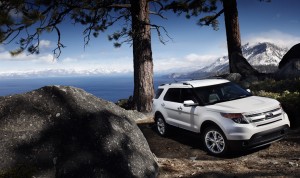
Ford has remade its Explorer sport utility vehicle, giving it car bones, but also the tools to leave the roads behind.
So, what is the difference between a crossover and an SUV, anyway? In the past, auto writers tended to classify an SUV as one of the old-style body-on-frame bruisers. Real trucks, based on their makers’ pickup truck, capable of going off-road. They came standard with rear-wheel drive, with optional four-wheel drive, no, not all-wheel drive, we’re talking about a system where the 4WD is engaged either by a lever, or more recently with buttons or a knob.
Ford wants us to classify its redesigned Explorer as an SUV, not a crossover. If it’s a crossover you want, then Ford would like to sell you a Flex. But can this completely remade Explorer still claim to be an SUV? Based on the same Volvo bones that underpin the Lincoln MKT and MKS and the Ford Taurus and, yes, even the Flex crossover, base Explorers are now front-wheel drive riding on a unibody platform.
Sure, much of this is just autowriter flimflam that matters little to the people who buy these rigs. When you boil it down to its essence, car buying revolves around three things: styling, capabilities and how it makes you feel. Oh, and we suppose the niggling issue of cost, and that whole price of ownership thing, has a little to do with it, as well.
So what about this Explorer’s capabilities? Not surprisingly, it handles better than the clunky old Explorer. The stiff unibody makes a big difference compared the old truck’s traditional frame.
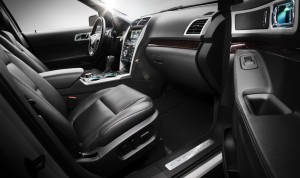
The Explorer's interior is loaded with Ford's increasingly more common technology, including MyFordTouch, the latest version of Sync.
Comparing acceleration and fuel mileage are hardly fair since the old truck was powered by Ford’s ancient 4.0-liter V-6, which was simply the worst engine offered by any automaker until Ford finally let it die. The base engine in the new Explorer is Ford’s excellent 3.5-liter V-6, rated at 290 horsepower in this installation. Already an efficient, modern engine, Ford made numerous improvements to coax as much fuel economy out of it as possible.
Inside, there’s more space, so passengers, particularly those in the third row, are more comfortable.
About the only area where the old Explorer betters its replacement is in towing capacity. Where the outgoing Explorer could tow 5,375 pounds (7,115 pounds with the optional V-8), the new one is limited to 5,000 pounds with its standard V-6.
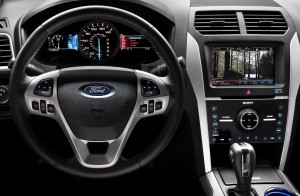
Like many of the latest crop of Fords, the Explorer has a slick, configurable instrument panel that gives far more information than the usual fuel level, engine temperature and speed.
Speaking of engines, Ford took a new approach compared to Dodge and its new Durango. Both sport utes come with standard V-6s of similar size and power, but they diverge when it comes to optional powerplants.
Dodge continues to offer its 5.7-liter V-8, so in many ways, it really is an update of the classic mid-size SUV formula. But Ford is emphasizing fuel economy, so the new optional engine is a 240-horsepower, 2.0-liter four cylinder that wears the EcoBoost moniker. Yes, that’s right a seven-passenger SUV with an engine that seems like was lifted straight from a sports coupe.
While the Explorer’s towing capacity is slightly more than the Flex (4,500 pounds), it falls short of the Durango, which can tow 6,100 pounds with the V-6, 7,400 pounds with the V-8.
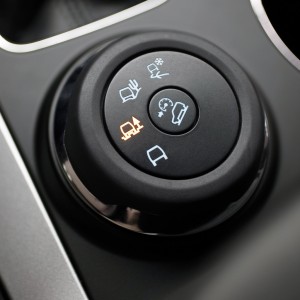
Ford surveyed Explorer owners and found that many didn't know when to use the 4WD lock button on their dashboards. So they replaced it with Terrain Management System, which allows the driver to select from four modes designed for specific surfaces.
Another big difference compared to the outgoing model is the optional all-wheel-drive system. Ford said that it found, in talking to Explorer owners, that many never used the knob that locked the 4WD system because they didn’t know what it would do. So Ford ditched that system for one that has four settings, normal, mud, sand and snow. Called Terrain Management System, each setting optimizes the transmission and AWD system for the terrain. It manages engine behavior, throttle tip-in, transmission shift scheduling and calibrations for traction and stability control systems.
But, as with most of its newest vehicles, Ford takes the technology even further. If so ordered, Ford will cram the thing full of some of the most advanced technology in the industry.
We’ve already offered a full critique of MyFordTouch, the newest version of the groundbreaking voice-controlled infotainment system, but we will say this: Sync works best in Ford’s quietest vehicles and the Explorer qualifies as one of the quietest. Interestingly, while carrying a rattling wheelbarrow in back, Sync was unable to comprehend any voice instructions. Otherwise, it did a good job with voice recognition.
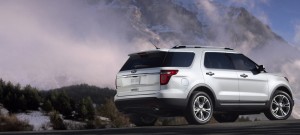
Ford's stylists walked the line between giving the Explorer an up-to-date look, while still remembering past models.
Click here to read our review of the Ford Edge, which included a full critique of MyFordTouch.
The Explorer is available with a couple of industry firsts, including the first-ever inflatable seatbelt, which is an option for the middle row.
It also introduces Curve Control, which is an extension of vehicle stability control. The system senses when a driver is taking a curve too quickly and reduces engine torque and can apply the brakes to rapidly slow the vehicle by as much as 10 mph in about a second.
The Explorer is easy to drive. It rides very well, gobbling up bumps comfortably. Acceleration is decent, maybe slightly better than the Durango V-6.
The six-speed transmission shifts smoothly, although it is a little slow to provide a downshift when extra power is requested. Manual shifting – there are buttons on the shift lever – is faster.
The interior – with lovely two-tone brown leather – is comfortable. The front seats have plenty of space and places to stash your stuff. Ford’s soon-to-be ubitquious configurable instrument panel offers plenty of options to help the driver see everything that is going on with the vehicle. A pair of four-way buttons control the system, which can be used to control some of the basic functions of the infotainment, navigation and climate-control systems.
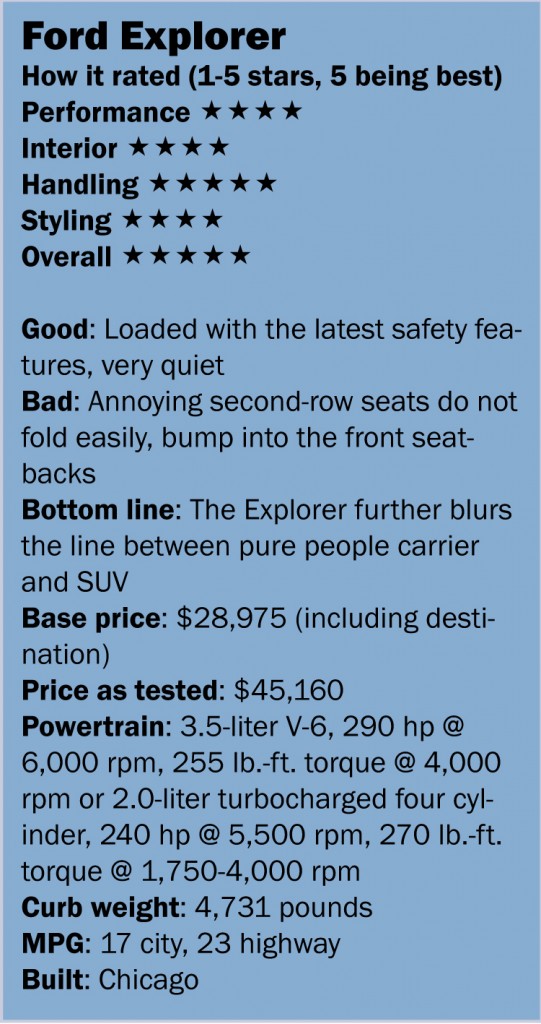 The 60/40 split middle row bench seat – a pair of buckets is an option on some models – have surprisingly tight kneeroom. As one might expect, headroom is very good. The fold-and-flip middle row seats do not work as well as those in the Durango. A major annoyance is that, unless a vertically challenged person has been sitting in the front seat, the seatback must be adjusted so the middle row will fold for entry to the third row. Really? Didn’t this bother anyone as Ford was testing the Explorer?
The 60/40 split middle row bench seat – a pair of buckets is an option on some models – have surprisingly tight kneeroom. As one might expect, headroom is very good. The fold-and-flip middle row seats do not work as well as those in the Durango. A major annoyance is that, unless a vertically challenged person has been sitting in the front seat, the seatback must be adjusted so the middle row will fold for entry to the third row. Really? Didn’t this bother anyone as Ford was testing the Explorer?
The optional third row is tight. Adults will fit back there, but the low cushion and lack of foot space will mean they will complain if the trip is longer than a few miles. The test vehicle had power-folding split rear seats that were sort of fun to watch as they did their motorized origami act.
If room in the second and third rows is a priority, you might want to look at the Flex, which has a longer wheelbase and overall length than the Explorer, giving it slightly more interior space.
Like the Flex, the Explorer’s third-row seats disappear into a well, as in a minivan. That hole expands cargo space when the seats are up.
One of the biggest differences between the Flex and Explorer is styling. Where the Flex is polarizing, the Explorer has a sophisticated design that suggests the adventure of a sport-ute. There’s a bit of family resemblance to the previous model.
One surprise is the Explorer has a small price advantage over the Flex considering the Explorer has added so much new technology compared to the older Flex.
The Explorer starts at $28,975 (including delivery) for a FWD model with the V-6. This Limited model opens at $39,995. A $4,100 package includes luxury seats, power liftgate, active park assist, rain-sensing wipers, adaptive cruise control, blind spot monitoring system and HID headlamps. White Platinum paint costs another $495 and towing adds $570 for an as-tested price of $45,160.
Whether the Explorer is a crossover or an SUV largely depends on what you want it to be. Just as many crossovers spend their days lugging kids to soccer practice or bringing a wheelbarrow to a friend’s house, the Explorer is up to the challenge.
But if light off-roading is part of the program, the Explorer is up to that challenge as well.

Have good friends who owned a previous generation Explorer they were very happy with. With 100K on the odo, it was time for a new one but alas, since they occasionally tow a track-prepped Boxster on a trailer, the new Explorer couldn’t handle the payload. So while they wanted the new Explorer, they instead bought a new Grand Cherokee, which has greater towing capacity. So for them, the new one was not “up to the challenge.”